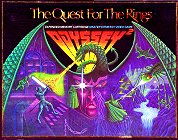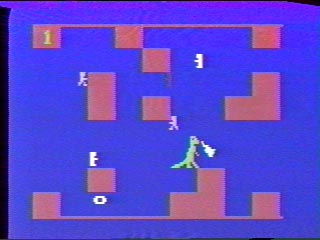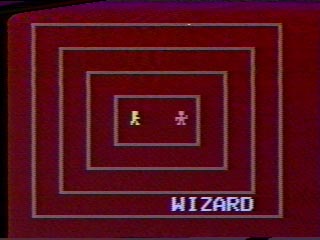 The Game: In the opening screen – the mists of time, so the rulebook tells us – two players pick their characters’ classes. Warriors are sword-wielding strongmen, wizards can cast spells from a distance, phantoms can walk through solid walls (but not lava formations), and changelings can become invisible when they move. The two intrepid adventurers then set forth on a quest to retrieve the ten rings of power from randomly selected dungeons and filled with randomly selected horrors. (Magnavox, 1980)
The Game: In the opening screen – the mists of time, so the rulebook tells us – two players pick their characters’ classes. Warriors are sword-wielding strongmen, wizards can cast spells from a distance, phantoms can walk through solid walls (but not lava formations), and changelings can become invisible when they move. The two intrepid adventurers then set forth on a quest to retrieve the ten rings of power from randomly selected dungeons and filled with randomly selected horrors. (Magnavox, 1980)
Memories: According to the rulebook, a third player (whew, is anyone else beginning to figure out why these games never caught on?) – acting as a dungeonmaster of sorts – selects the combination of mazes and monsters to challenge the players, based upon their position on a map (the aforementioned gameboard).  (Of course, it was just as easy to get only one other person to play, choose some random combinations of dungeons and critters, and kick some serious medieval butt.)
(Of course, it was just as easy to get only one other person to play, choose some random combinations of dungeons and critters, and kick some serious medieval butt.)
Quest For The Rings was one of Magnavox’s first two “Master” series games, slightly overcomplicated epics that incorporated board game elements and complex rules – and video game components which were, ultimately, simplistic at best.
 Quest For The Rings, however, has always been my pick as the best of the Master Series. It takes its cues from a famous contemporary, Dungeons & Dragons. At least the game play – stripped down of its would-be-grandiose-if-they- made-sense role playing game trappings – was good enough to sustain itself, even as a solo game. Orcs gather
Quest For The Rings, however, has always been my pick as the best of the Master Series. It takes its cues from a famous contemporary, Dungeons & Dragons. At least the game play – stripped down of its would-be-grandiose-if-they- made-sense role playing game trappings – was good enough to sustain itself, even as a solo game. Orcs gather  round you in overwhelming numbers, the deathwings and spydroths (the latter of which, rather disturbingly, gobble you up pretty graphically if they catch you) cannot be harmed, and the dragon…whew. Let’s not even talk about the dragon. He’s good for a suicidal laugh.
round you in overwhelming numbers, the deathwings and spydroths (the latter of which, rather disturbingly, gobble you up pretty graphically if they catch you) cannot be harmed, and the dragon…whew. Let’s not even talk about the dragon. He’s good for a suicidal laugh.
